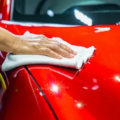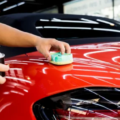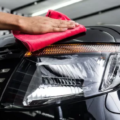PPF vs. Ceramic Coating vs. Graphene Coating – Which Offers the Best Protection for Your Car?
When it comes to maintaining your car’s appearance, protecting its paint is crucial. A well-maintained paint job can enhance the aesthetic appeal of your vehicle and increase its resale value. To help keep your car looking brand new, many car owners turn to protective coatings like Paint Protection Film (PPF), Ceramic Coating, and Graphene Coating. Each of these products offers unique benefits, but which one is right for you? In this blog, we’ll explore each option, compare their advantages, and help you make an informed decision about which is best for your car.
What is Paint Protection Film (PPF)?
Paint Protection Film, often referred to as PPF or clear bra, is a thin, transparent film applied to the exterior surfaces of your car. Made from thermoplastic urethane, PPF serves as a protective shield against scratches, rock chips, and other forms of damage. It’s a clear coating that blends seamlessly with your car’s paint, so it doesn’t alter the look of your vehicle, while still providing top-tier protection.

Benefits of PPF
One of the biggest benefits of PPF is that it provides excellent protection from minor scratches and rock chips. This makes it especially useful for high-impact areas like the front bumper, hood, and side mirrors, where damage is most likely to occur. The film absorbs the impact, preventing the paint from getting damaged.
Another advantage of PPF is its self-healing property. Small scratches and swirl marks that occur on the surface of the film will disappear over time as the film reacts to heat (like from the sun) or warm water. This makes PPF a low-maintenance option for keeping your car’s paint in pristine condition.
PPF also provides protection from UV rays, preventing your car’s paint from fading or oxidizing. Over time, UV exposure can cause the paint to lose its vibrancy, but with PPF, the paint stays fresh and bright for longer.
What is Ceramic Coating?
Ceramic coating is a liquid polymer applied to the exterior of your car. Once applied, the ceramic bonds with the paint, creating a hydrophobic (water-repellent) layer. This layer provides an additional level of protection for your car’s paint, making it easier to clean, more resistant to scratches, and less prone to damage from environmental factors like dirt, water, and UV rays.
Benefits of Ceramic Coating
One of the main benefits of ceramic coating is its hydrophobic properties. When water comes into contact with a ceramic-coated surface, it beads up and rolls off, carrying dirt and grime with it. This helps to keep your car cleaner for longer and reduces the need for frequent washing.
In addition to water repellency, ceramic coating also provides protection against light scratches. While it may not offer as much protection as PPF in terms of impact resistance, it does help guard against swirl marks and minor abrasions that can occur from regular washing or everyday driving.
Ceramic coatings are also known for their long-lasting durability. When properly applied, ceramic coatings can last for several years, providing consistent protection from the elements. The coating helps maintain the car’s shiny finish and prevents the paint from fading due to UV exposure.
What is Graphene Coating?
Graphene coating is a newer technology that uses graphene, a single layer of carbon atoms arranged in a hexagonal pattern, to provide protection for your car’s paint. Graphene coatings combine the benefits of ceramic coatings with the unique properties of graphene, offering an even more durable and advanced form of protection.
Benefits of Graphene Coating
Graphene coatings offer superior durability compared to traditional ceramic coatings. The graphene layer is stronger and more resilient, providing an extra layer of protection against scratches, dirt, water, and UV rays. This makes graphene coatings an excellent option for those seeking maximum protection for their car.
Like ceramic coatings, graphene coatings also have hydrophobic properties. Water beads up and rolls off the surface, which helps keep your car clean and makes washing easier. However, graphene coatings take this property to the next level, offering even better water repellency and helping to maintain a clean surface for longer periods.
One of the standout features of graphene coatings is their enhanced heat resistance. Graphene is known for its ability to withstand high temperatures, making this coating ideal for protecting your car in hot climates or for those who frequently drive in extreme weather conditions.
PPF vs. Ceramic Coating vs. Graphene Coating – The Key Differences
While all three options—PPF, Ceramic Coating, and Graphene Coating—offer protection for your car’s paint, they do so in different ways. Here’s a breakdown of how each one compares in terms of key features:
Durability
PPF is generally the most durable option when it comes to protecting against scratches, chips, and physical impacts. Its self-healing property allows it to recover from minor scratches, making it a great choice for high-risk areas like the front bumper and hood.
Ceramic coatings offer a high level of durability, but they are not as effective as PPF when it comes to protecting against impacts. While ceramic coatings provide excellent protection against dirt, water, and UV rays, they don’t offer the same level of impact resistance.
Graphene coatings offer superior durability, surpassing even ceramic coatings in terms of strength. The graphene layer provides excellent protection against scratches, UV rays, and water. It also offers enhanced heat resistance, making it ideal for a wider range of driving conditions.
Hydrophobic Properties
Both ceramic and graphene coatings are known for their hydrophobic properties, meaning they repel water and help keep your car clean by allowing water and dirt to roll off easily. However, graphene coatings outperform ceramic coatings in this area, providing even better water repellency.
PPF does not have the same hydrophobic qualities as ceramic or graphene coatings. While it protects your paint from scratches and chips, it doesn’t offer the same water-repelling benefits. For those looking for easy maintenance and water protection, ceramic or graphene coatings may be a better option.
Scratch Resistance
While PPF is the best at protecting your car from physical damage, including scratches and chips, ceramic and graphene coatings do offer some level of scratch resistance. Graphene coatings are especially strong in this area, providing superior scratch resistance compared to ceramic coatings.
Ceramic coatings can help prevent light scratches and swirl marks, but they won’t provide the same level of protection as PPF or graphene coatings when it comes to physical impacts.
Maintenance
In terms of maintenance, ceramic and graphene coatings are both easy to maintain. The hydrophobic properties make cleaning your car easier, as dirt and water won’t stick as much to the surface. Both coatings require regular washing to maintain their effectiveness, but they make cleaning quicker and more efficient.
PPF requires less frequent maintenance, but it still needs to be properly cared for. It is essential to keep the film clean and free from contaminants to ensure it continues to provide optimal protection.
Which One is Right for You?
Choosing between PPF, ceramic coating, and graphene coating depends on your priorities. If you’re looking for the highest level of protection against scratches and chips, PPF is the best option. It offers the most robust defense against physical impacts and keeps your car’s paint looking fresh.
If you’re looking for an easy-to-maintain, hydrophobic coating that provides protection from dirt and UV rays, ceramic coating might be the best choice. It’s a great option for those who want a low-maintenance solution that still provides reliable protection.
If you want the most advanced protection with superior durability, hydrophobic properties, and enhanced heat resistance, graphene coating is the way to go. It’s ideal for those who want the latest in car protection technology.
Conclusion
Each of these options—PPF, ceramic coating, and graphene coating—has its own strengths, and the right choice for you depends on your specific needs and priorities. Whether you’re looking for the ultimate protection against physical damage, a hydrophobic coating that makes maintenance easier, or the latest in cutting-edge technology, there’s a solution for every car owner. Regardless of which option you choose, investing in paint protection is a smart decision that will help preserve the look and value of your car for years to come. Give your car the pampering it needs with the best services to your nearest store in Gurgaon. Schedule your appointment with us today and give your car the pampering it needs.










